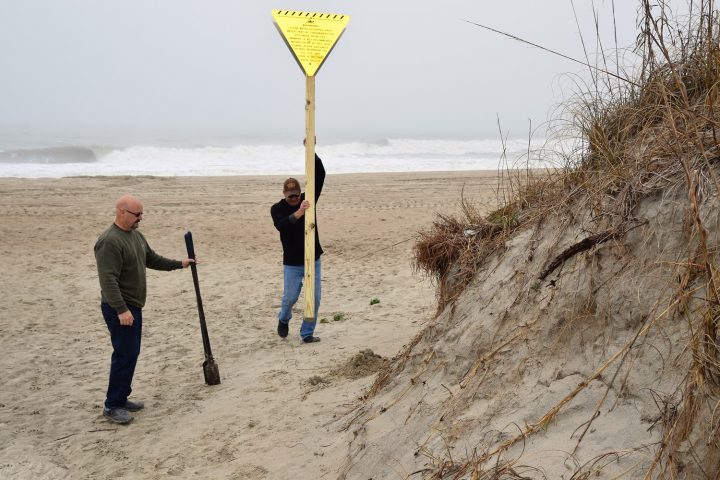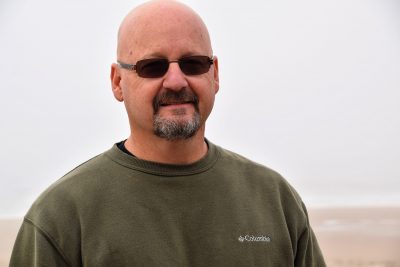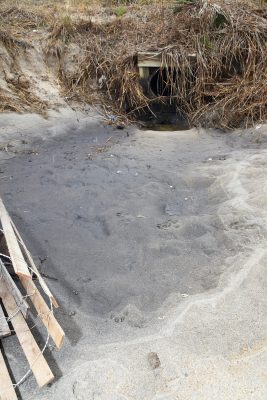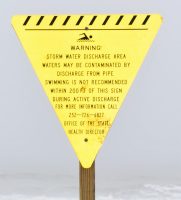
MOREHEAD CITY – The man who has led the state office responsible for making sure coastal waters are safe for swimmers and others is calling it a career after more than 30 years on the job.
J.D. Potts, head of the Recreational Water Quality Program in the North Carolina Division of Marine Fisheries, will work his last day on Thursday, Feb. 28, leaving the office in the hands of a new chief for the first time since its inception in 1997.
Supporter Spotlight
He’ll also leave behind a legacy: Since the program started, he said in a recent interview, there has never been a documented case of anyone, anywhere, getting sick from swimming in North Carolina’s coastal waters.
“We’ve had some complaints,” he said, “but nothing documented by a doctor.”
Potts said he’s proud of his career and the work of the staff, and he feels he’s leaving the office in good shape.

The program tests 204 swimming sites, most on a weekly basis during the swimming season, which runs from April through September. All ocean beaches and high-use, soundside beaches are tested weekly from April through September; lower-use beaches are tested twice a month.
All sites are tested twice a month in October and monthly from November through March. Water quality sampling results for all locations are posted on the program’s website.
Supporter Spotlight
All of those samples are tested for enterococcus bacteria, an indicator organism found in the intestines of warm-blooded animals. While enterococcus doesn’t cause illness itself, its presence is correlated with that of organisms that can cause gastrointestinal and other illnesses and symptoms.
When enterococcus levels exceed state standards, Potts’ office puts up an advisory sign, warning the public to stay out of the water. There’s no statutory authority to actually forbid people from swimming when a sign goes up, but most heed the advisories. The staff returns as soon as reasonable to take new samples, and takes the sign down when it’s safe again. Archived information about swimming advisories are posted on the website.
The program has been a bit controversial in the past.
“When we first started, there were a good many complaints about what we did,” Potts said. “You’d hear things like, ‘This house rents for $1,000 or $1,200 a week, and you’re telling me we can’t go in the water?’ We don’t hear that as much now. We’ve really tried to work to educate the public, as well as the managers in the local governments, and I think it’s worked. I think most people understand now that it’s for everyone’s benefit.”
In essence, he said, people now generally realize that the impact of a warning sign put up at a site for a day or two, or even longer, pales in comparison to the possible health risks, and to the likely impact on the coastal tourism-based economy if North Carolina were to get a reputation for having unsafe swimming waters.
Potts’ career began in 1989, shortly after he graduated from North Carolina State University, where he studied soil science.

A friend in the program got a job with the Onslow County Health Department and told Potts, a Mocksville native, about another opening. He applied, and got the job. Not long after that, there was an opening in the state shellfish sanitation section, which was then under the Department of Health, and he applied and got that one, too.
He started as a “shoreline sampler,” going out every day to look at possible sources of pollution that would foul and result in the closure of shellfish harvesting.
In the 1980s and 1990s, though, North Carolina’s coast got some seriously bad publicity about some seriously bad water quality problems. Remember overflowing hog waste lagoons near rivers that lead to the coast? It’s a problem that still occurs from time-to-time. Remember Pfiesteria? That was the toxic dinoflagellate associated with harmful algal blooms and fish kills. Remember massive fish kills?
Eventually, the state got called a “beach bum,” by the Natural Resource Defense Council, for not having a recreational water sampling program. Officials decided to start one and fund it, and Potts was named its chief.
Growing up in the Piedmont, he was always interested in soil, trees and the environment.
Potts worked for a time on a tree farm owned by his high school Future Farmers of America teacher, and he always loved being outside. After high school, he went to Davidson Community College – there wasn’t enough money to start his education in a university – before joining the Army for a while and eventually heading to NCSU to study soil science and graduating in December 1988.
Over the span of his career, Potts said, he’s been pleased to see North Carolina’s ocean swimming waters remain largely clean, except during isolated instances like major flooding and stormwater discharges after hurricanes.
“I think we have a good reputation,” he said. “People know that if they come to our beaches, they’re going to be able to get in the water and swim.”
That’s a little less true, of course, on the sound side of the barrier islands, where increased development and the attendant increase in stormwater runoff is more problematic without the incredible dilution capacity of the ocean. Closures generally occur after heavy rain events, as the rain washes pollutants from roads and other hard surfaces into the waters.
Generally, Potts said, soundside water quality is good, but it’s not unusual for those “don’t swim” advisory signs to pop up.
But the state, he feels, does a much better job now than it did years ago to retest those waters quickly, and to get the signs down fast.
That’s made those local government managers and administrators, not to mention tourism interests and beachgoers, happier.
“We’ve worked hard to develop good relationships with them,” Potts said of local government officials, “and we try to give them a ‘heads-up’ about potential problems to try to reduce the anxiety.”
Potts doesn’t foresee serious water quality problems on the ocean side – “I think it’s ‘good’ to ‘excellent’ now,” he said, adding that it’s likely to stay that way. But he fears that continued development will result in some declines at some sites along the sounds and creeks.
“We may see more closures at some places as time goes by,” he said.
“I think we have a good reputation. People know that if they come to our beaches, they’re going to be able to get in the water and swim.”
J.D. Potts, Chief, Recreational Water Quality Program
Potts said he thinks the state and local governments do a fairly good job regulating development that leads to runoff, at least when compared to the past.
“When I started in 1997, there really weren’t any rules,” he said.
Things began to improve in the early 2000s, he said, culminating in the General Assembly in 2004 adopting a stormwater runoff bill. It was supported by local governments and some developers, but opposed by most environmental groups, who thought the law was too weak. Studies showed the groups were right.
New stormwater rules adopted by the Environmental Management Commission in January 2008 were then approved by the North Carolina Rules Review Commission, passed during the General Assembly’s short session in May 2008 and signed into law by Gov. Mike Easley in August 2008.
Now, at least some coastal towns and counties have developed their own stormwater runoff rules.
Potts isn’t one to publicly blast people, including politicians, but he’s not sure there isn’t more that should be done.
He said the state’s enterococcus standards are strict enough, though.
For Tier 1 waters – areas where swimming occurs daily during the April 1-Oct. 31 “season,” including any public access swimming areas and any other swimming areas where people use the water for primary contact, including all oceanfront beaches – the standard for closure is anything in excess of a geometric mean of 35 enterococci per 100 milliliter of water, that includes a minimum of at least five samples collected within 30 days, or a single sample of 104 enterococci per 100 milliliter of water.
For Tier 2 waters – a swimming area used an average of three days a week during the swimming season – the standard is anything in excess of 276 enterococci per 100 milliliter of water. And for Tier 3 waters – a swimming area used an average of four days a month during the swimming season – it’s anything over 500 enterococci per 100 milliliter of water in two consecutive samples.
Although waters are tested in the “winter season,” which runs Nov. 1 through March 31, in most cases swimming advisories are not issued during that period.
“If the standard wasn’t high enough, you’d see more advisory signs than you do,” Potts said.
Potts has long had a good relationship with environmentalists, including those in the Coastal Federation, as have others in his office and in the shellfish sanitation office. They’ve all generally been strong advocates for reasonable rules that protect not just public health, but also the coastal environment.
The soon-to-be-retiree is proud of those good relationships, too.
“It makes me feel good that we’ve been able to work together, all up and down the coast,” he said. “I’m glad that they respect the program.”
Potts said he’ll miss the job and the wide variety of people he’s worked with during his 30-year tenure.
One of those is Steve Murphey, who worked with Potts for years in shellfish sanitation, but is now director of the fisheries division. He and Potts are close friends.
“He’s been a mentor to me,” Murphey said. “He did a lot of training when I first started out over there. He taught me a lot. It’s, well, you, you put the book down at some point and go out and learn it in the real world. And that’s what we did.”
Murphey said the state is losing a man who’s a combination of a gifted scientist and a person with great people skills.
“He’s going to be really tough to replace,” he said.
Potts, Murphey said, developed, or “pioneered,” many of the sampling techniques and analyses that are still used. Even when he was a shoreline surveyor before he was head of the recreational waters program, Murphey said, Potts was an expert at identifying the polluted discharges that fouled some of North Carolina’s coastal waters.
“He was a great trainer, and he knew how to work with those (local government officials),” he said. “He taught me a whole lot.”
But Potts is excited about retirement. It will give him the chance to spend more time with his family and to enjoy his hobbies, including woodworking.
“It’s been a hobby of mine since high school, and I’m looking forward to doing more,” he said. “People give me timber and I make furniture. I’m going to start making natural tables.”
He’s also going to take welding classes.
“I’ll stay busy,” he said. “I wanted to retire young enough to be healthy and enjoy doing the things I love.”









